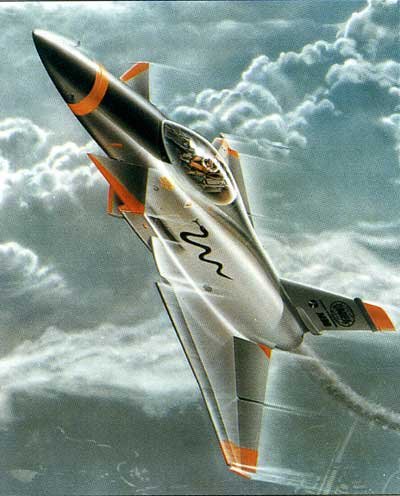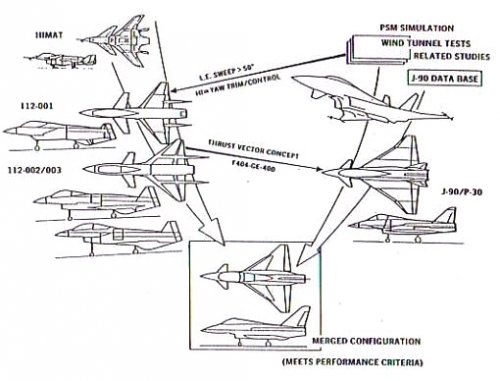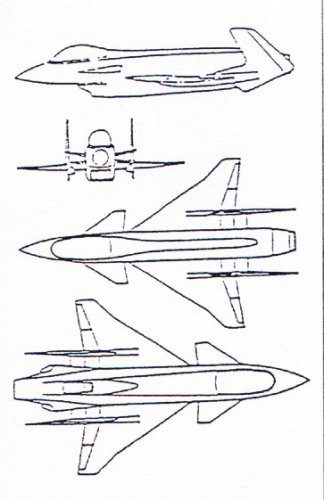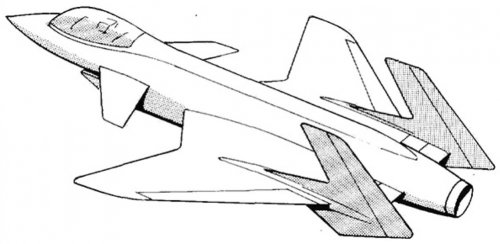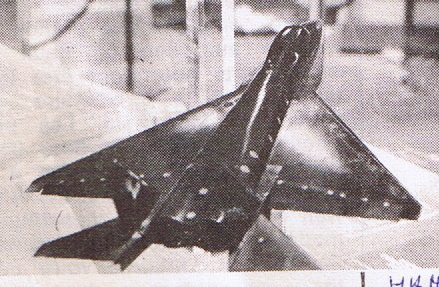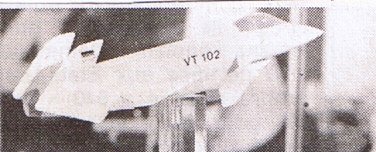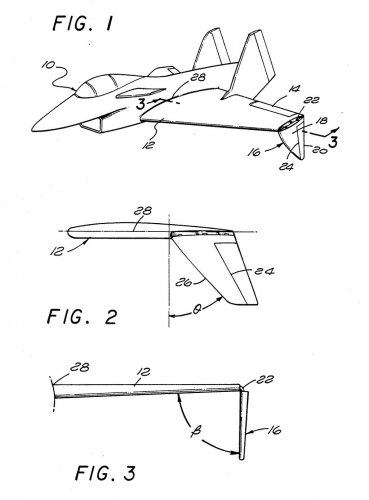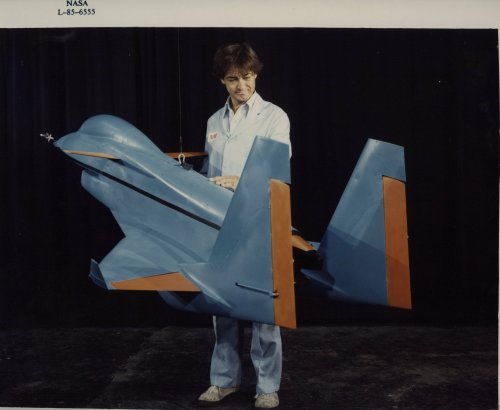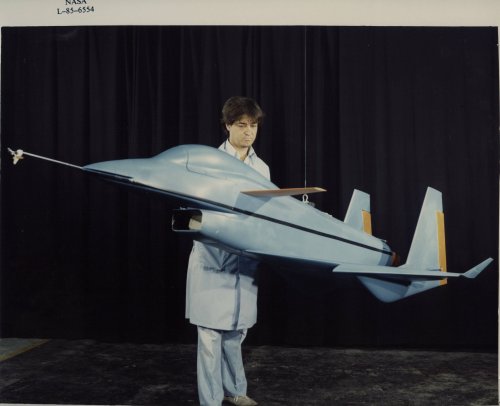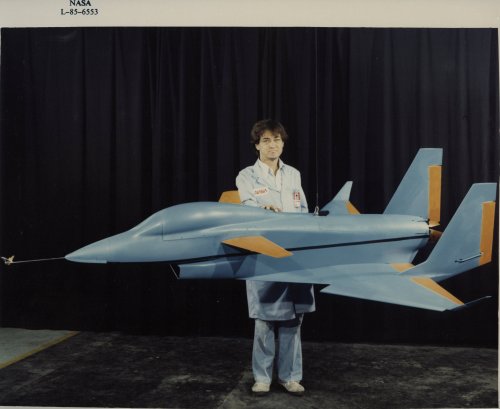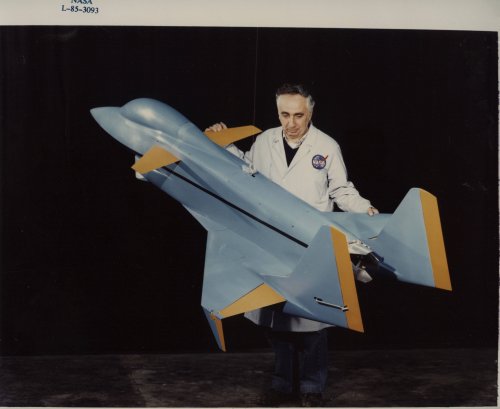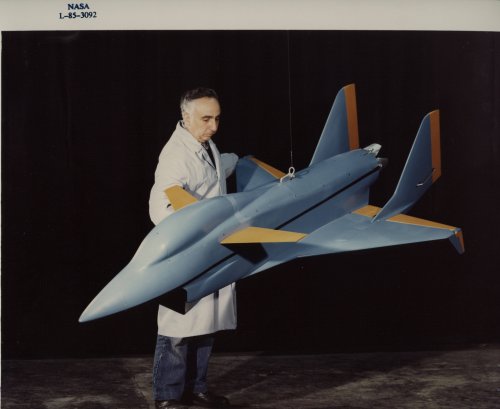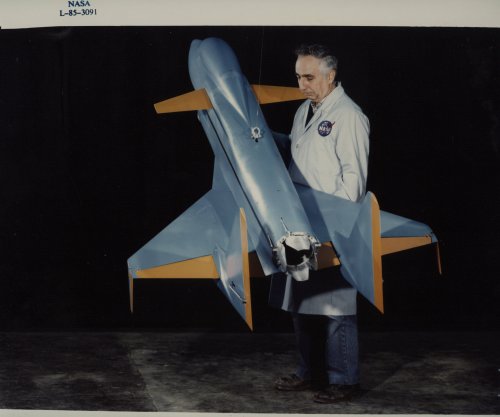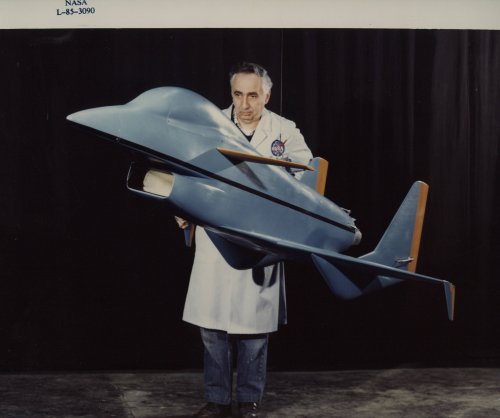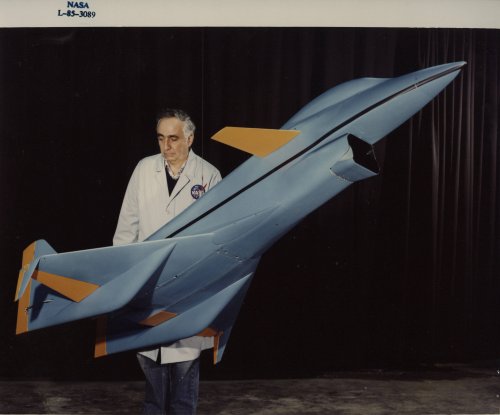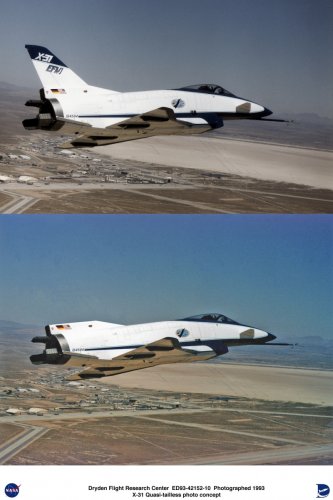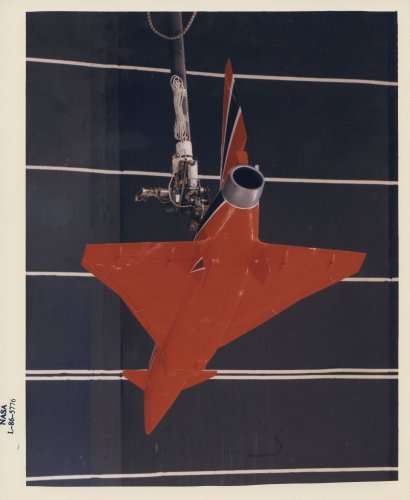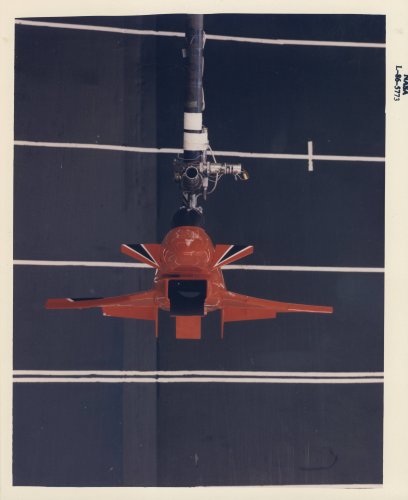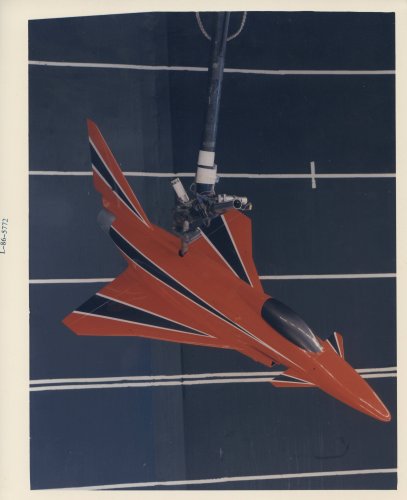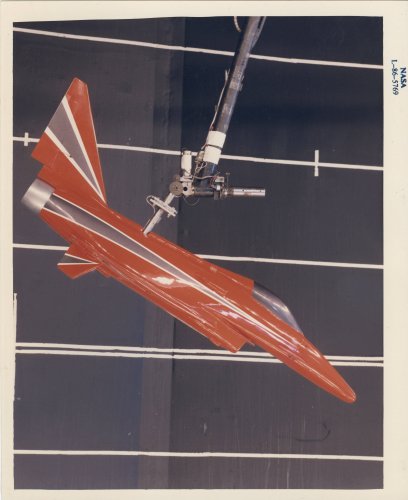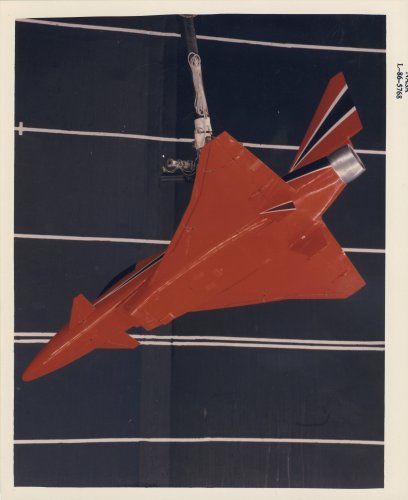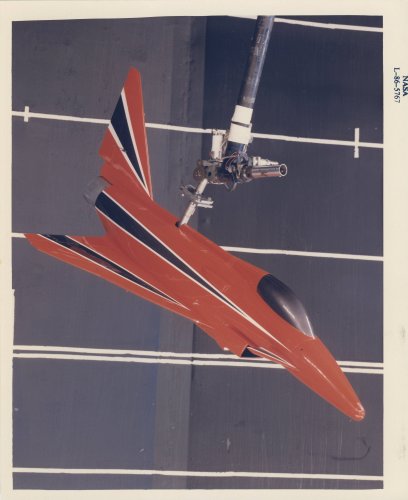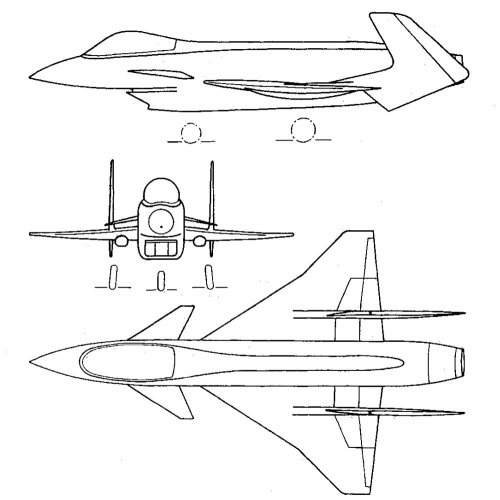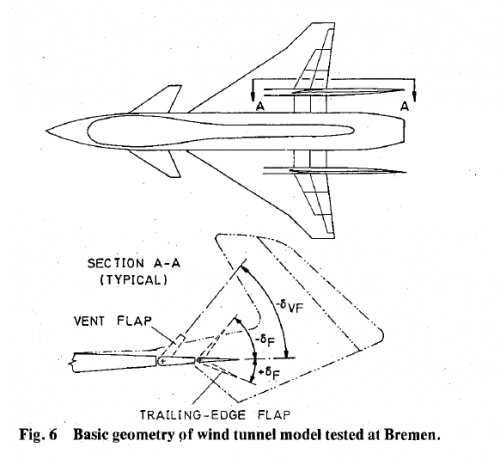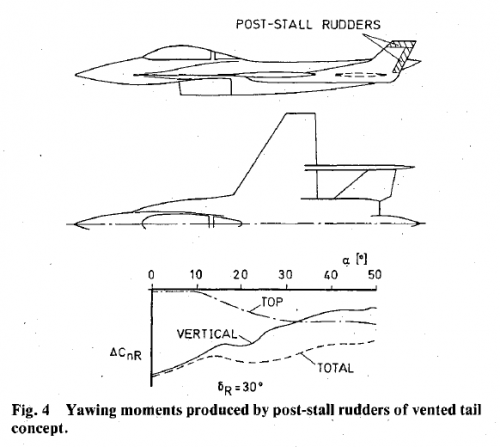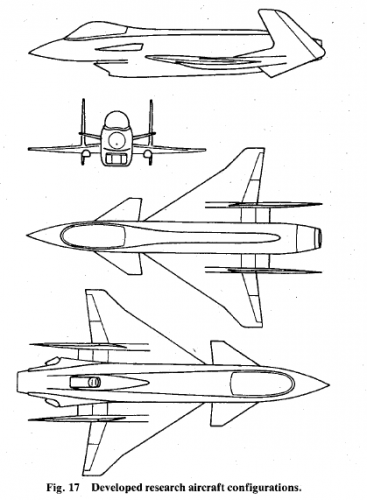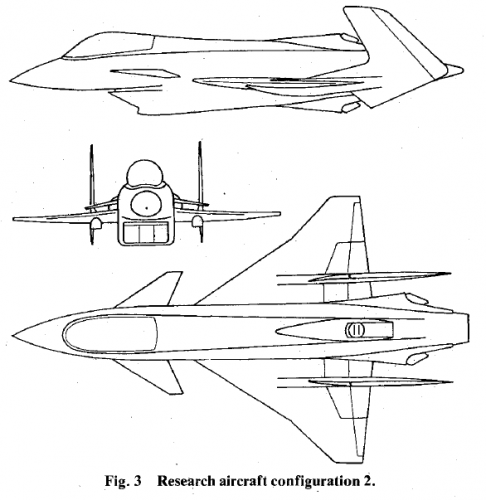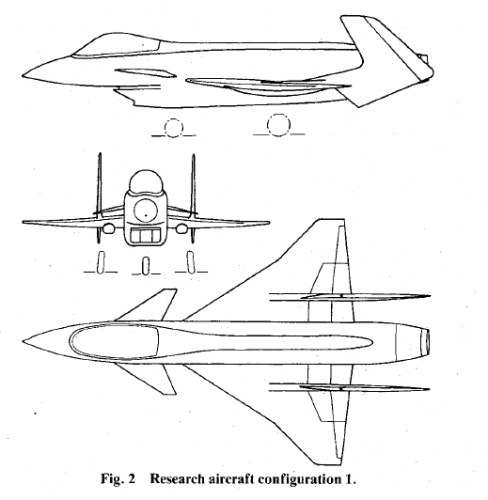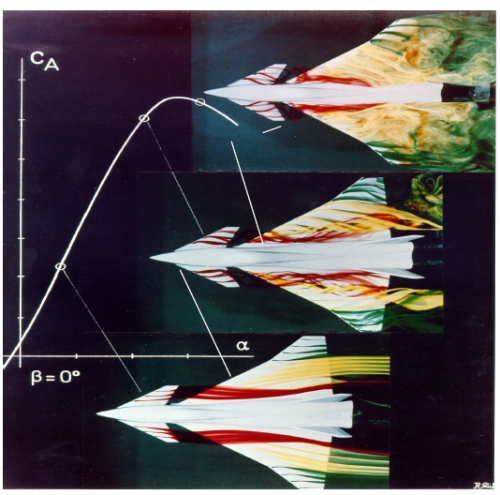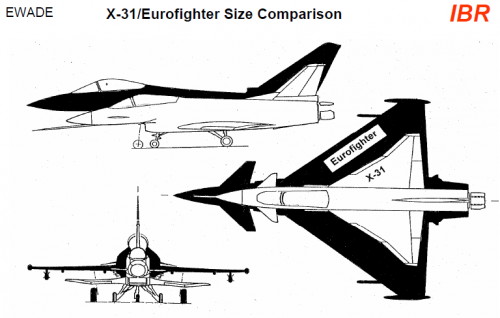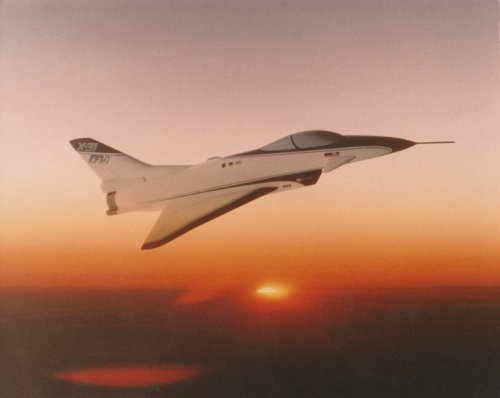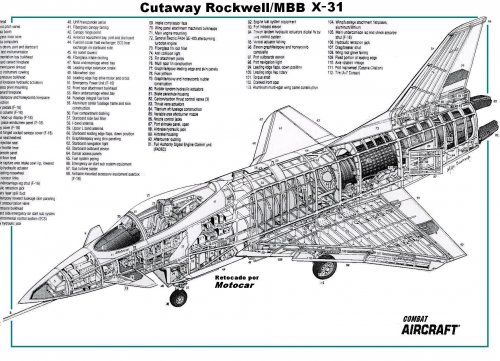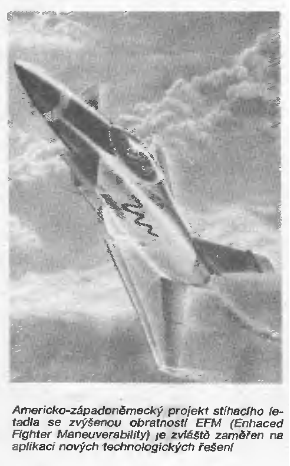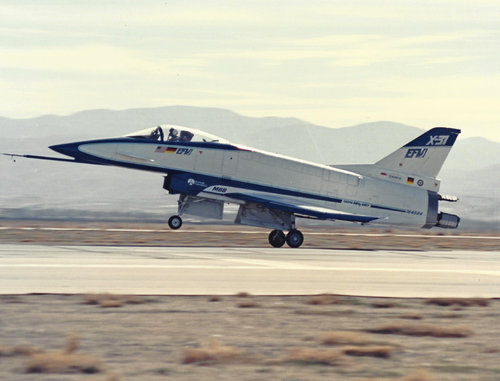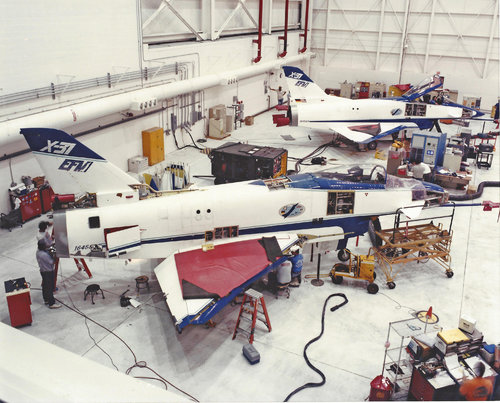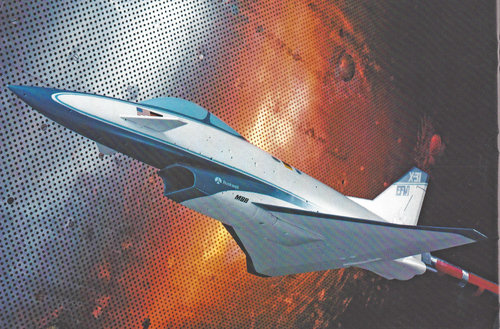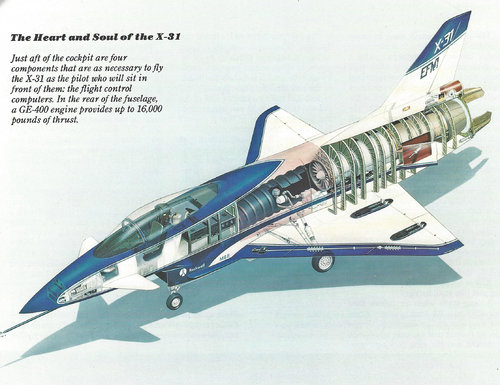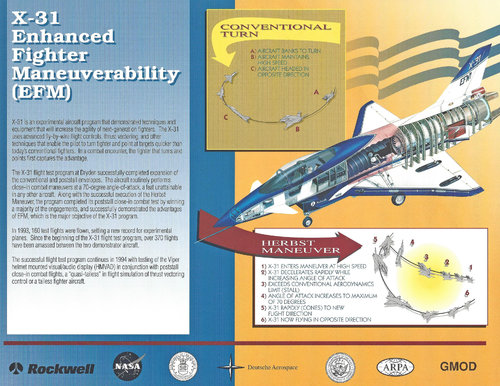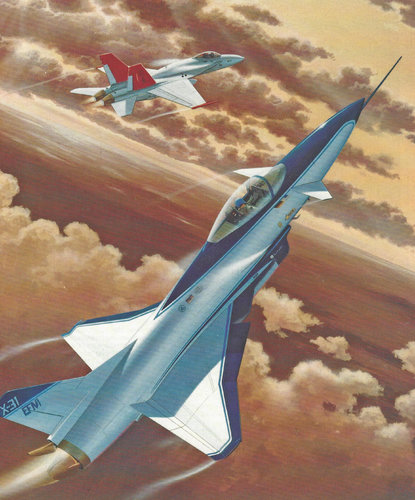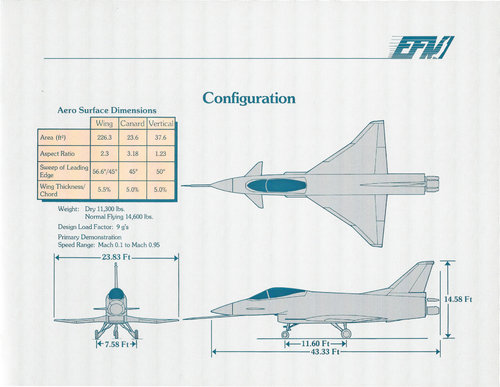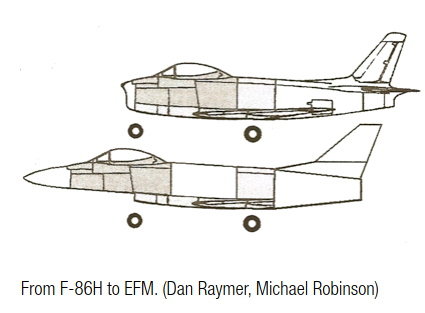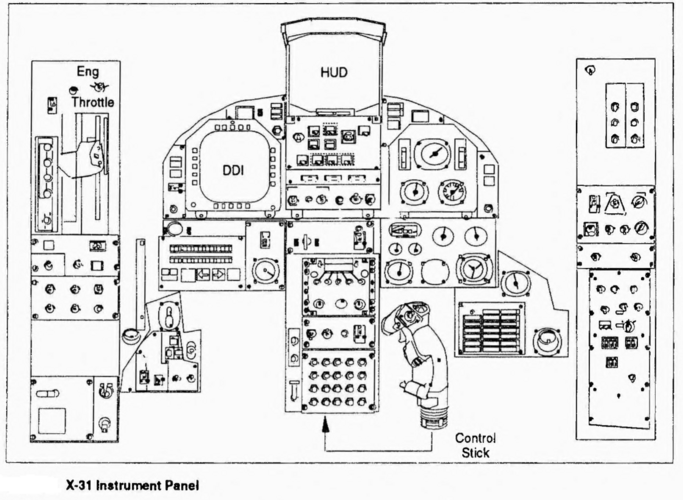You are using an out of date browser. It may not display this or other websites correctly.
You should upgrade or use an alternative browser.
You should upgrade or use an alternative browser.
Rockwell / MBB X-31 Design Evolution
- Thread starter hesham
- Start date
- Joined
- 27 December 2005
- Messages
- 17,664
- Reaction score
- 25,694
It was an early configuration of what evolved into the Rockwell/MBB X-31 project
- Joined
- 27 December 2005
- Messages
- 17,664
- Reaction score
- 25,694
The initial SNAKE configuration bore a superficial resemblance to the earlier HiMAT design (canard and wing-mounted twin vertical tails); however, the new configuration was designed analytically with computers and a minimum amount of wind-tunnel tests. Unfortunately, Croom’s aerodynamic tests of the initial SNAKE configuration in the Langley 30- by 60-Foot (Full-Scale) Tunnel indicated unacceptable stability and control characteristics. The configuration was unstable in pitch, roll, and yaw for all angles of attack.
Based on their extensive experience with stability and control characteristics of advanced fighters, Croom and Johnson provided the Rockwell team with several recommendations to cure the problems exhibited by the SNAKE configuration. The configuration modifications resulted in satisfactory characteristics, and the aerodynamic deficiencies of the initial SNAKE design had been eliminated. Rockwell was grateful for the guidance and innovation contributed by Langley in the evolution of the SNAKE configuration.
http://oea.larc.nasa.gov/PAIS/Partners/X_31.html
[Removed picture - better copy below - Admin]
- Joined
- 27 December 2005
- Messages
- 17,664
- Reaction score
- 25,694
richard
ACCESS: Top Secret
- Joined
- 1 May 2006
- Messages
- 578
- Reaction score
- 140
It seems that VFW was involved too ,and that the X-31 and TFK were closely related .
- Two VFW studies for the TFK shown at the Hannover Salon in 1980 (Air et Cosmos 1980)
- VFW-FSW (1982) shown by Overscan in the TFK topic
- X-31 4 views as tried at Langley (Luftfahrtfoschung in Deutschland ; Hirschel,Prem,Madelung; Bernard&Graefe Verlag 2001)
- Two VFW studies for the TFK shown at the Hannover Salon in 1980 (Air et Cosmos 1980)
- VFW-FSW (1982) shown by Overscan in the TFK topic
- X-31 4 views as tried at Langley (Luftfahrtfoschung in Deutschland ; Hirschel,Prem,Madelung; Bernard&Graefe Verlag 2001)
Attachments
- Joined
- 27 December 2005
- Messages
- 17,664
- Reaction score
- 25,694
In 1981, VFW was taken over by MBB, having been merged with Fokker to form VFW-Fokker in 1969, but then de-merged to form an independent company again in 1980.
This should help. From 1981 VFW was part of MBB.
Last edited:
- Joined
- 27 December 2005
- Messages
- 17,664
- Reaction score
- 25,694
Rockwell SNAKE patent here:
US5072894A
US5072894A
US5072894A - Apparatus and method for increasing the angle of attack operating range of an aircraft - Google Patents
An apparatus and method for increasing the angle of attack operating range of an aircraft is disclosed. The invention comprises a pair of substantially vertical tip fins. Each vertical tip fin has a main portion and an aft portion. The main portion is securely connected to the tip of the...
patents.google.com
Attachments
Last edited:
- Joined
- 27 December 2005
- Messages
- 17,664
- Reaction score
- 25,694
Thanks to Dan Raymer's autobiography "Living in the Future" we can understand the design progression now.
The original SNAKE design was developed by Rockwell Columbus division as the LA division were too busy with B-1 work. Later on, the project was returned to LA division, but it was too different to the MBB (TKF-90) configurations to use any of the MBB work. The Germans were putting in money and wanted it to look like the Eurofighter they were developing while the US fighter effort at that time was all stealthy and hence classified. Rockwell's LA division essentially started the design again with something that looked more like the Eurofighter. Result - happy Germans
There's a lot more about it and other projects in the book, so buy it for the full story
The original SNAKE design was developed by Rockwell Columbus division as the LA division were too busy with B-1 work. Later on, the project was returned to LA division, but it was too different to the MBB (TKF-90) configurations to use any of the MBB work. The Germans were putting in money and wanted it to look like the Eurofighter they were developing while the US fighter effort at that time was all stealthy and hence classified. Rockwell's LA division essentially started the design again with something that looked more like the Eurofighter. Result - happy Germans
There's a lot more about it and other projects in the book, so buy it for the full story
- Joined
- 27 December 2005
- Messages
- 17,664
- Reaction score
- 25,694
Attachments
Steve Pace
Aviation History Writer
- Joined
- 6 January 2013
- Messages
- 2,266
- Reaction score
- 222
Didn't the X-31 fly a few times without its vertical tail? -SP
Machdiamond
ACCESS: Secret
- Joined
- 15 January 2007
- Messages
- 325
- Reaction score
- 32
This question came up in another thread some time ago I think. Ah here it is: http://www.secretprojects.co.uk/forum/index.php/topic,2987.0/highlight,x-31.html
No it never flew without its vertical tail but the flight control system laws were modified to simulate tailless handling qualities for a study that was illustrated by a photo montage.
--Luc
No it never flew without its vertical tail but the flight control system laws were modified to simulate tailless handling qualities for a study that was illustrated by a photo montage.
--Luc
- Joined
- 25 June 2009
- Messages
- 14,665
- Reaction score
- 5,834
Machdiamond said:No it never flew without its vertical tail but the flight control system laws were modified to simulate tailless handling qualities for a study that was illustrated by a photo montage.
Here is photographic evidence of this: the same picture published with and without the tail fin. Please note that the caption says "Photo concept".
Attachments
- Joined
- 27 December 2005
- Messages
- 17,664
- Reaction score
- 25,694
Here's some interesting stuff on the SNAKE / early X-31.
As richard suggested earlier in the topic, it turns out the initial SNAKE configuration was developed at VFW (later, MBB) in 1980 as an alternate TKF study. It was sent to Rockwell to work on and give to NASA to test, as both companies were interested in post-stall manouvering.
This wasn't the only configuration tested - there was also this scaled-down single engine MBB TKF-90 design.
Source: Stephen Ransom Configuration Development of a Research Aircraft with Post-Stall Maneuverability in AIAA Journal of Aircraft, 1983
http://crgis.ndc.nasa.gov/historic/...els_and_Tests_N-Z#X-31_and_Rockwell-MBB_Snake
As richard suggested earlier in the topic, it turns out the initial SNAKE configuration was developed at VFW (later, MBB) in 1980 as an alternate TKF study. It was sent to Rockwell to work on and give to NASA to test, as both companies were interested in post-stall manouvering.
This wasn't the only configuration tested - there was also this scaled-down single engine MBB TKF-90 design.
Source: Stephen Ransom Configuration Development of a Research Aircraft with Post-Stall Maneuverability in AIAA Journal of Aircraft, 1983
http://crgis.ndc.nasa.gov/historic/...els_and_Tests_N-Z#X-31_and_Rockwell-MBB_Snake
Attachments
- Joined
- 26 May 2006
- Messages
- 34,677
- Reaction score
- 15,504
Hi,
I think this research fighter configurations from MBB/VFW led to develop the Eurofighter
at the end.
Configuration development of a research aircraft with post-stall maneuverability
http://arc.aiaa.org/doi/abs/10.2514/3.44917?journalCode=ja
I think this research fighter configurations from MBB/VFW led to develop the Eurofighter
at the end.
Configuration development of a research aircraft with post-stall maneuverability
http://arc.aiaa.org/doi/abs/10.2514/3.44917?journalCode=ja
Attachments
- Joined
- 2 August 2006
- Messages
- 3,250
- Reaction score
- 1,507
hesham said:Hi,
I think this research fighter configurations from MBB/VFW led to develop the Eurofighter
at the end.
http://arc.aiaa.org/doi/abs/10.2514/3.44917?journalCode=ja
No, those were the designs that led to the X-31 post stall maneuvering demonstrator.
royabulgaf
ACCESS: Top Secret
- Joined
- 29 December 2008
- Messages
- 676
- Reaction score
- 339
Nice color scheme on the wind tunnel model. GulfHawk updated?
- Joined
- 13 June 2007
- Messages
- 2,172
- Reaction score
- 3,065
Very interesting video - thanks Flateric! Mark
ScrutorAudax
ACCESS: Confidential
- Joined
- 4 June 2015
- Messages
- 66
- Reaction score
- 99
Hesham, are the nodes on each side of the aircraft depicted in Fig. 17 (MBB-VFW 3.png) for translational thrust in post-stall maneuvers?
- Joined
- 26 May 2006
- Messages
- 34,677
- Reaction score
- 15,504
ScrutorAudax said:Hesham, are the nodes on each side of the aircraft depicted in Fig. 17 (MBB-VFW 3.png) for translational thrust in post-stall maneuvers?
Hi Scrutor,
to be honest,I don't know,maybe someone can help.
- Joined
- 26 May 2006
- Messages
- 34,677
- Reaction score
- 15,504
Later Rockwell artist's concept of SNAKE - almost X-31 configuration already
From L+K 3/1988,it's first time for me to know it was called EFM,Enhaced Fighter Maneuverability.
.
Attachments
- Joined
- 25 July 2007
- Messages
- 4,283
- Reaction score
- 4,126
From L+K 3/1988,it's first time for me to know it was called EFM,Enhaced Fighter Maneuverability.
The joint US-German research project was called the Enhanced Fighter Maneuverability program so the X-31 prototypes became the 'EFM demonstrators'.
- Joined
- 29 January 2008
- Messages
- 914
- Reaction score
- 2,026
Not design evolution but hopefully still interesting.
Attachments
- Joined
- 3 June 2006
- Messages
- 3,086
- Reaction score
- 3,903
Herbst-Manöver... 
Ah, ok, not Autumn-Maneuver, but named after Dr. Wolfgang Herbst, a remarkable pioneer of extreme maneuverability who tragically died before his concept realized its fullest potential.
Source (Links updated on 2024-02-05):
PDF: https://www.nasa.gov/wp-content/uploads/2015/03/Flying_Beyond_the_Stall.pdf
Book (Epub/mobi): https://www.nasa.gov/aeronautics/flying-beyond-the-stall/ (Free download!)
Edit:
I highly recommend the chapter "Origins, Design, and Development of the X-31"!
Ah, ok, not Autumn-Maneuver, but named after Dr. Wolfgang Herbst, a remarkable pioneer of extreme maneuverability who tragically died before his concept realized its fullest potential.
Source (Links updated on 2024-02-05):
PDF: https://www.nasa.gov/wp-content/uploads/2015/03/Flying_Beyond_the_Stall.pdf
Book (Epub/mobi): https://www.nasa.gov/aeronautics/flying-beyond-the-stall/ (Free download!)
Edit:
I highly recommend the chapter "Origins, Design, and Development of the X-31"!
[...]Of all these, the Sabre—the most elegant and evocative of all early jet-age airplanes—had the greatest appeal. Old ex–Air National Guard F-86H aircraft were available from the Navy at Naval Air Station (NAS) China Lake, where they were being converted into target drones. The figure to the right shows how an F-86H might have been converted into the Enhanced Fighter Maneuverability program [EFM].
Making this an attractive proposition was that the entire tail of the F-86 comes off for engine removal, meaning that a new tail section could easily be fabricated to use the same attachment points.
The portions of the F-86 that the EFM would use are indicated in the figure as the shaded areas of the forward fuselage and the wing box.
The cockpit is moved forward from the midsection and the “hole” behind the cockpit is filled in with a “flat-wrapped” skin over a new internal structure.
A chin inlet, nose cone, and canard are added, and then the F-86 wing leading and trailing edges are removed and replaced with a delta wing around the old F-86 structural wing box.
Further increasing the idea’s attractiveness is that many parts and components from the original F-86H could be reused, including the wing box and carry-through structure,
tricycle landing gear, cockpit and canopy, large portions of the fuselage, engine mounts, fuel system, and many subsystems.
Rockwell’s Dan Raymer built a foam-board model to show how it would be done. Though the F-86 was an understandable choice for the EFM project, concerns over the likely fatigue
life of an elderly airframe that was at least 30 years old, as well as its relatively heavy fuselage weight, led to dropping the Sabre from contention.[...]
Attachments
Last edited:
Motocar
I really should change my personal text
- Joined
- 16 May 2014
- Messages
- 1,059
- Reaction score
- 1,079
Good for speculative cutaway drawing...!Herbst-Manöver...
Ah, ok, not Autumn-Maneuver, but named after Dr. Wolfgang Herbst, a remarkable pioneer of extreme maneuverability who tragically died before his concept realized its fullest potential.
Source:
PDF: https://www.nasa.gov/sites/default/files/files/Flying_Beyond_the_Stall.pdf
Book(Epub/mobi): https://www.nasa.gov/connect/ebooks/flying_beyond_the_stall_detail.html (Free download!)
Edit:
I highly recommend the chapter "Origins, Design, and Development of the X-31"!
[...]Of all these, the Sabre—the most elegant and evocative of all early jet-age airplanes—had the greatest appeal. Old ex–Air National Guard F-86H aircraft were available from the Navy at Naval Air Station (NAS) China Lake, where they were being converted into target drones. The figure to the right shows how an F-86H might have been converted into the Enhanced Fighter Maneuverability program [EFM].
Making this an attractive proposition was that the entire tail of the F-86 comes off for engine removal, meaning that a new tail section could easily be fabricated to use the same attachment points.
The portions of the F-86 that the EFM would use are indicated in the figure as the shaded areas of the forward fuselage and the wing box.
La cabina se mueve hacia adelante desde la sección media y el "agujero" detrás de la cabina se rellena con una piel "envuelta plana" sobre una nueva estructura interna.
Se agregan una entrada de mentón, un cono de nariz y un canard, y luego se eliminan los bordes de ataque y de salida del ala del F-86 y se reemplazan con un ala delta alrededor de la antigua caja de ala estructural del F-86.
Lo que aumenta aún más el atractivo de la idea es que muchas piezas y componentes del F-86H original podrían reutilizarse, incluida la caja del ala y la estructura de transporte.
tren de aterrizaje triciclo, cabina y toldo, grandes porciones del fuselaje, soportes del motor, sistema de combustible y muchos subsistemas.
Dan Raymer de Rockwell construyó un modelo de tablero de espuma para mostrar cómo se haría. Aunque el F-86 fue una elección comprensible para el proyecto EFM, las preocupaciones sobre la probable fatiga
life of an elderly airframe that was at least 30 years old, as well as its relatively heavy fuselage weight, led to dropping the Sabre from contention.[...]
RavenOne
ACCESS: Top Secret
- Joined
- 18 June 2008
- Messages
- 995
- Reaction score
- 2,644
Have seen the second (and surviving testbed) at the Deutsches Museum at Oberschleißheim Flugplatz. back in 2017 when the GA airfield celebrated 7 decades or so nice fly ins and great to walk around their museum. The airfield till 1973 was a US Army in Europe USAREUR that operated everything from Sikorsky CH-34 Choctaw to Grumman OV-1D Mohawk and to Huey....i highly recommend the museum.
Anyhow here are my photos of said piece.





cheers
Anyhow here are my photos of said piece.
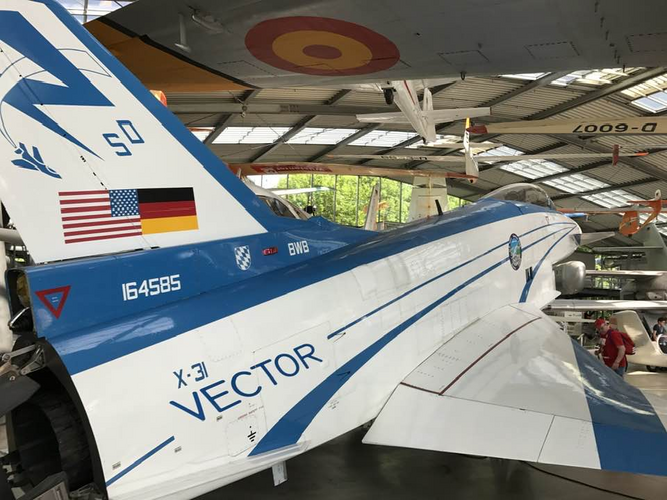
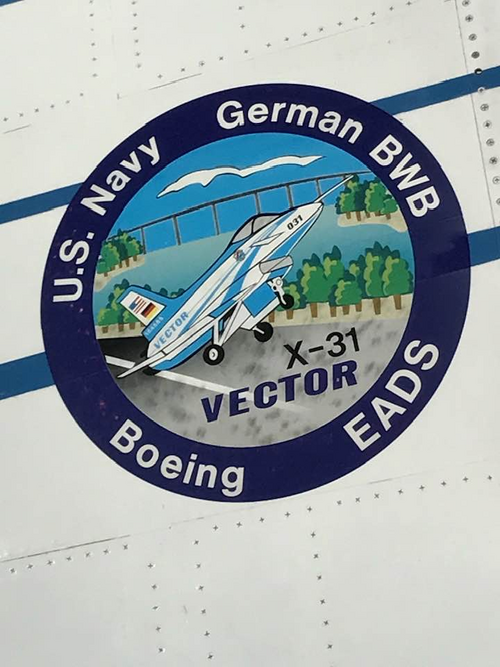
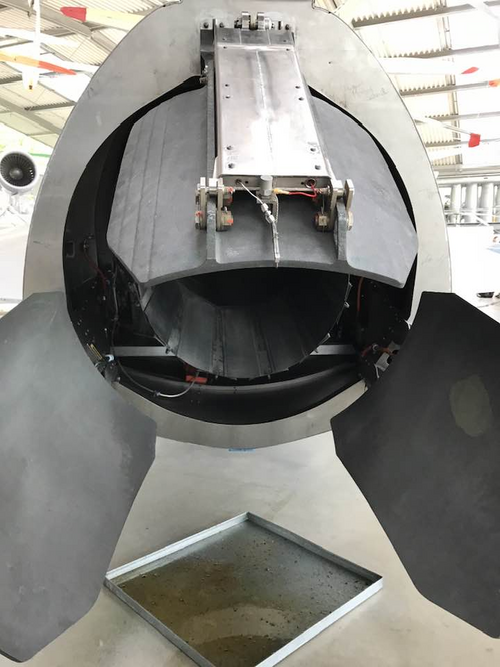
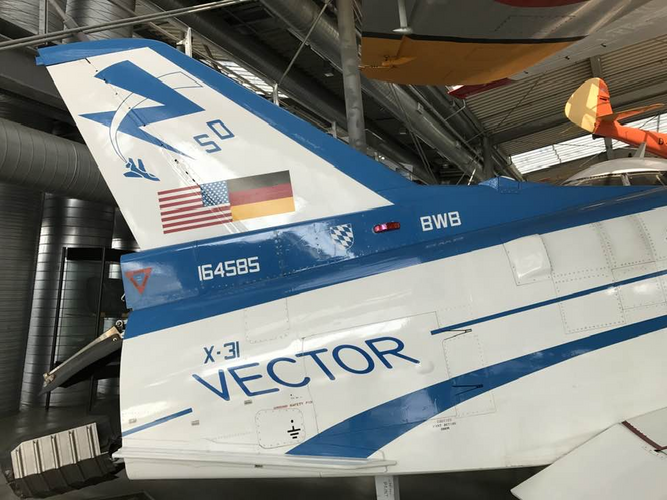
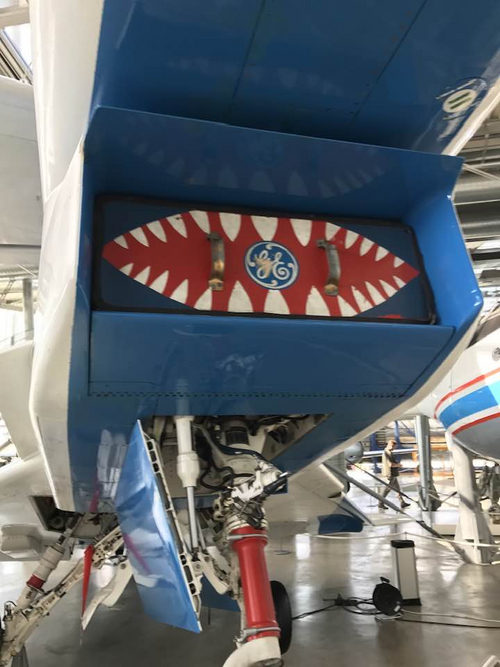
cheers
- Joined
- 27 December 2005
- Messages
- 17,664
- Reaction score
- 25,694
Nice photos - thanks for sharing.Have seen the second (and surviving testbed) at the Deutsches Museum at Oberschleißheim Flugplatz. back in 2017 when the GA airfield celebrated 7 decades or so nice fly ins and great to walk around their museum. The airfield till 1973 was a US Army in Europe USAREUR that operated everything from Sikorsky CH-34 Choctaw to Grumman OV-1D Mohawk and to Huey....i highly recommend the museum.
Anyhow here are my photos of said piece.
View attachment 700371
View attachment 700372
View attachment 700373
View attachment 700374
View attachment 700375
cheers
Scott Kenny
ACCESS: USAP
- Joined
- 15 May 2023
- Messages
- 11,067
- Reaction score
- 13,286
Those forward-swept vertical stabilizers just look weird.
- Joined
- 27 December 2005
- Messages
- 17,664
- Reaction score
- 25,694
Langley Contributions to the X-31
In 1984, Rockwell proposed a cooperative program to Langley to assess and develop a Rockwell advanced design known as the Super Normal Attitude Kinetic Enhancement( SNAKE) configuration.
Joseph R. Chambers and Joseph L. Johnson, Jr. determined that the proposal was in concert with many Langley research interests in high- angle-ofattack technology, and the cooperative program on the SNAKE configuration was begun. Langley researcher Mark A. Croom was assigned the role of lead engineer, and he began a decade of personal participation in the X- 31 evolution and flight -test programs. The initial SNAKE configuration bore a superficial resemblance to the earlier HIMAT design ( canard and wing-mounted twin vertical tails ) ; however, the new configuration was designed analytically with computers and a minimum amount of wind-tunnel tests.
Unfortunately, Croom's aerodynamic tests of the initial SNAKE configuration in theLangley 30- by 60 - Foot ( Full - Scale ) Tunnel indicated unacceptable stability and controlcharacteristics. The configuration was unstable in pitch , roll, and yaw for all angles of attack. Based on their extensive experience with stability and control characteristics of advanced fighters , Croom and Johnson provided the Rockwell team with several recommendations to cure the problems exhibited by the SNAKE configuration.
The configuration modifications resulted in satisfactory characteristics, and the aerodynamic deficiencies of the initial SNAKE design had been eliminated. Rockwell was grateful for the guidance and innovation contributed by Langley in the evolution of the SNAKE configuration. In the early 1980's, an awareness of the benefits of thrust vectoring for dramatically improved control at high angles of attack surfaced. In addition to studies of advanced engine concepts with vectoring nozzles, interest arose over the use of simple thrust vectoring paddles in the engine exhaust to deflect the thrust for control augmentation.
As discussed in Langley Contributions to the F-14 , the Navy, with Langley's assistance, had taken the lead in this area with flight tests on an F-14 modified with single -axis yaw- vectoring paddles. In addition, during a cooperative program with Rockwell led by Langley researcher Bobby L. Berrier, Langley provided design data for multiaxis thrust vectoring paddle configurations using the Jet Exit Test Facility in 1985. Based on these fundamental research studies, Rockwell incorporated multiaxis thrust- vectoring paddles into the SNAKE configuration. Free - flight tests of the modified SNAKE model in theFull - Scale Tunnel by Croom's team in 1985 provided an impressive display of the effectiveness of thrust vectoring at extreme angles of attack.
In West Germany, Dr. Wolfgang Herbst of Messerschmitt-Bolkow-Blohm (MBB) aggressively touted the advantages of post-stall technology ( PST) for increased effectiveness during close-in air combat. Herbst's conclusions were based on windtunnel tests of a German advanced canard fighter configuration known as the TKF-90 and piloted simulator studies during which the application of simulated thrust vectoring resulted in rapid directional turns at high angles of attack had increased the turn rate by over 30 percent.
Technical discussions between the Rockwell SNAKE Program managers and Herbst were initiated in 1983 , and planning for a mutual program on PST ensued. Discussions with the Defense Advanced Research Projects Agency (DARPA )were very positive . When funding for collaborative international activities became available from the U.S. ( the Nunn-Quayle research and development initiative in 1986 ) and West German governments, the technical expertise of Rockwell and MBB were joined under DARPA sponsorship in the X- 31 Program .
In view of Langley's extensive experience in high-angle-of-attack technology, unique test facilities, and contributions to the Rockwell SNAKE Program , DARPA requested in 1986 that Langley become a participant in the X- 31 development program .
The Rockwell and MBB X- 31 design team merged their configuration candidates into acanard fighter powered by a single General Electric F404 engine with a single vertical tail . The initial design included an F- 16 canopy for cost- saving purposes. Extensive tests of the initial X- 31 configuration were carried out at Langley during 1987. These tests included static wind- tunnel tests and configuration component evaluations in the Langley 14- by 22- Foot High - Speed Tunnel, rotary - balance tests in the Langley 20 - Foot Vertical Spin Tunnel to determine aerodynamic characteristics during spins, and dynamic force tests in the Langley Full - Scale Tunnel .
Unfortunately, in 1988 the X- 31 configuration was revised , and an F- 18 canopy was incorporated. This change was regarded as significant, and a major portion of the previous wind- tunnel tests had to be repeated for the revised configuration. Rotary-balance tests of the revised configuration were conducted in 1988, and spin tests and static and dynamic tests were completed in 1989 for the updated configuration. In 1989, a 0.19- scale model of the X- 31 underwent extensive aerodynamic and free-flight tests in the Langley Full-Scale Tunnel.
Results from these ground -based studies indicated that the X - 31 might have marginal nose- down control at high angles of attack and that the configuration might exhibit severe , unstable lateral oscillations ( wing rock ) that would result in a violent, disorienting roll departure and an unrecoverable inverted stall condition. Fortunately, the results also indicated that a simple control law concept could prevent the aircraft from entering a spin . The awareness that such phenomena might exist for the full - scale aircraft enabled the X- 31 design team to configure the flight control system for maximum effectiveness .An exhaustive test , which included 498 paddle and nozzle configurations of the multi axis thrust -vectoring system, was conducted by Langley researcher Francis J. Capone in the Jet Exit Test Facility during 1988.
These data were used to select the final paddle and nozzle multiaxis thrust- vectoring configuration. These data were also critical to the design of the X- 31 flight control system , since vectored thrust imposes large forces and moments in addition to the normal aerodynamic parameters .A 0.27 - scale drop model was used by Langley to evaluate the post- stall and out- of control recovery characteristics of the configuration. The model, which weighed about 540 lb and included extensive instrumentation , was flown without an engine to assess the capabilities and characteristics of the basic airframe. The objective was to demonstrate that the X - 31 would be agile and have satisfactory characteristics without the additional augmentation provided by thrust vectoring. The drop -model test identifies characteristics and large amplitude flight motions that cannot be assessed in conventional wind or spin tunnels. In the X- 31 Program , the technique proved to be invaluable as an early indicator of the highly unconventional behavior of the configuration . In particular, the violent roll departure indicated by tests of the free- flight model was encountered during the drop -model tests . Several control schemes were evaluated to eliminate this problem . In addition , the drop -model test technique provided solutions to barrier problems during the full - scale flight - test program .
X-31 Flight Demonstration Program
The first flight of the first X-31 aircraft occurred at Palmdale, California, on October 11 ,1990, and the second aircraft made its first flight on January 19, 1991. During the initial phase of flight- test operations at the Rockwell facility at Palmdale, the two aircraft wereflown on 108 test missions . On the test missions, the aircraft achieved thrust vectoring inflight and expanded the post- stall envelope to 40-deg angle of attack. Operations were then moved to Dryden in February 1992, at the request of DARPA .At Dryden, the International Test Organization ( ITO) expanded the flight envelope ofthe aircraft, including military utility evaluations that compared the X- 31 to similarly equipped aircraft for maneuverability in simulated combat. The ITO, managed by DARPA, included NASA, the U.S. Navy, the U.S. Air Force, Rockwell Aerospace, the Federal Republic of Germany, and Deutsche Aerospace ( formerly Messerschmitt-Bolkow-Blohm). The first NASA flight under the ITO took place in April 1992.
As the X-31 full - scale aircraft flight tests began at Dryden, the Langley staff maintained a close support role for consultation and ground testing capability. Two problems surfaced during the X- 31 flight- test program , and both were considered significant enough to curtail flight tests until solutions were found. The first problem was encountered in the flight - test program when it became apparent that the pitch control effectiveness of the aircraft at post- stall conditions ( particularly at aft center of gravity conditions ) was marginal. Pilots reported that their ability to obtain positive, crisp, nose- down aircraft response was unsatisfactory and that increased control effectiveness was required if the X- 31 was to be considered tactically responsive at high angles of attack . As part of the X- 31 Team , Langley was requested to conduct windtunnel tests to explore options to provide the increased control at high angles of attack. Mark Croom and his team quickly responded and evaluated 16 configuration modifications to improve nose -down recovery capability in the Full- Scale Tunnel.
Mark Croom and his team quickly responded and evaluated 16 configuration modifica tions to improve nose -down recovery capability in the Full- Scale Tunnel. Results of the Investigation recommended that a pair of 6- by 65- in . strakes be mounted along the fuselage afterbody to promote nose- down recovery. The Langley recommendations, which were given within a week of the test request, provided a timely solution to the problem .The aft-fuselage strakes were incorporated in the X-31 , and the pilots reported that the nose-down control was significantly improved. The second problem that occurred in the X- 31 full- scale flight test was caused by large out of trim asymmetric yawing moments at high angles of attack . Shortly into the high angle- of-attack, elevated - g phase of the envelope expansion, a departure from controlled flight occurred as the pilot was performing a maneuver at 60- deg angle of attack . Data analysis by the X- 31 team indicated that aa large asymmetric yawing moment, in excess of the available control power, had triggered the departure. In response to an urgent request for solutions, Croom and the Langley team conducted tests in the Langley Full Scale Tunnel to design nose strakes that would minimize the problem . Once again, Langley responded rapidly with a strake configuration that permitted the flights to continue. The X- 31 Program logged an X-plane record of 524 flights in 52 months with 14 pilots from NASA, the U.S. Navy, the U.S. Marine Corps, the U.S. Air Force, the German Air Force, Rockwell International, and Deutsche Aerospace .Evaluation of the X- 31 as an enhanced fighter maneuverability demonstrator by the ITO concluded in early 1995.
Partners in Freedom
www.google.co.nz
This video summarizes what the quasi-tailless test programme was supposed to do and how it worked in a simplifyed way.
Not exactly related to the design evolution, but this thread is now de-facto X-31 thread on the forum so why not.
- Joined
- 26 May 2006
- Messages
- 34,677
- Reaction score
- 15,504
The link is died,so here is the live one,
Hey! Can you share the link where you found this picture? I am actually modelling an x31 in 3d and this kind of documentation can really helpFound on the internet.
Similar threads
-
The Rockwell/MBB X-31 Alternate History
- Started by YouCantbeCirrus
- Replies: 36
-
-
PAH-2: alternatives to and evolution of the Tiger attack helicopter
- Started by overscan (PaulMM)
- Replies: 55
-
MBB/ERNO (Einstufiger) LuftAtmender Raketen-Träger (LART)
- Started by Barrington Bond
- Replies: 17
-
What if Germany went through with VTOL aircraft?
- Started by helmutkohl
- Replies: 53

